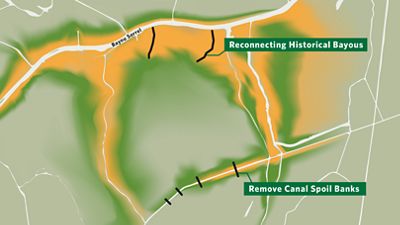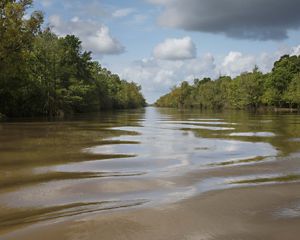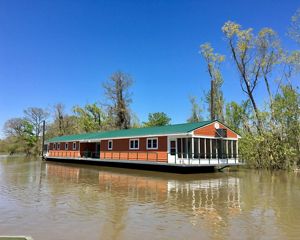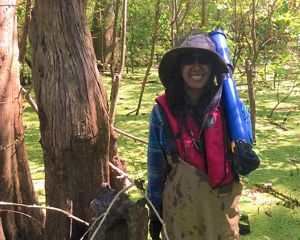Bad Water Out, Good Water In
Restoring water quality so that trees, plants and wildlife can thrive.

The Atchafalaya River Basin has been a conservation priority for The Nature Conservancy for many years. As the largest wetland and swamp in the United States, it represents a significant natural resource that impacts humans and wildlife from near and far. Protecting this irreplaceable landscape means working with all who depend on it to ensure its ecological health and productivity for future generations.
Pulse of a River
Years in the making, TNC is embarking on a hydrological restoration project to reconnect the swamp forest located at our 5,000-acre Atchafalaya Preserve with the river. Since 2017, TNC has been moving through proper channels and teaming up with the State of Louisiana and other partners to develop this project that aims to modify portions of the federal floodway to support more natural water flows.
Currently the river’s course—which is mostly fast and straight due to years of manipulations—is diverted away from wetlands that are key to filtering water and trapping harmful pollution and sediment flowing downstream. In turn, these wetlands are cut off from the river’s ebbs and flows and subsequent oxygenation, required for healthy cypress trees, wild crawfish and other plants and animals characterizing this unique ecosystem.
Atchafalaya Basin Restoration
-
Decades of dredging and other hydrologic manipulations have altered the Basin’s natural water flows, creating toxic pools of stagnant water called dead zones. Completely cut off from sources of flowing water, dead zones result in degraded water quality, reduced forest health and damaged habitat for wildlife.
-
Remove harmful dead zones by reinstating the historic north-to-south water flow pattern through the floodplain.
-
To do this, we shave down man-made spoil banks and establish drains through canal banks in the south, bringing good water in and pushing bad water out.

Benefits of Restoration
The Atchafalaya Restoration Project, which serves as a pilot, involves cutting small gaps in portions of levee banks to invite water into the swamp from the north and send it back to the river in the south. Allowing the water to move between the river and swamp, as nature intended, should yield significant benefits for water quality and wildlife habitat, as well as for recreation and commercial fishing. If successful, it could potentially guide actions in a broader system that drains two-thirds of the country.
Quote: Joe Baustian
Every day there are large- and smaller scale systems that control the flow and direction of the Atchafalaya River. In pursuing these manipulations, we’ve lost important connections between the river and surrounding floodplain.
Monitoring Results
How will we know if reinstating these natural processes are succeeding in rejuvenating this critically important landscape? Together with federal, state and academic partners, TNC has established a rigorous monitoring program charged with studying the project's effects on the ecosystem. Specifically, 15 monitoring stations have been set up throughout the swamp to observe and measure data, which has already indicated that reconnecting the swamps would improve water quality, enhance tree growth, and produce healthier and more numerous crawfish and fish.
Become a Change-Maker
When you stand up for nature, you stand up for our future. Your support for The Nature Conservancy ensures that our conservation work in Louisiana is possible! Help us protect the local lands and waters we all depend on for recreation, livelihoods and survival.



